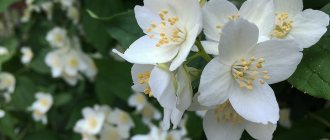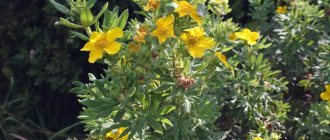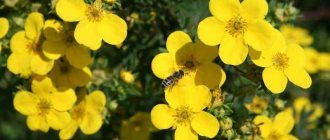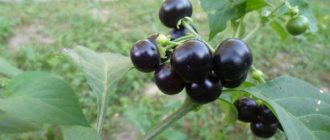Encyclopedia of Plants
St. John's wort is a wild perennial plant (some species are annual) from the St. John's wort family with characteristic ovate leaves and yellow flowers. With proper care and planting, it can organically complement an extraordinary landscape design.
- 1 Description of the plant 1.1 Types and features of growing St. John's wort
- 1.2 Subtleties of planting and care
- 2.1 Medicinal properties
Description of the plant St. John's wort
St. John's wort is a herbaceous perennial rhizomatous plant with erect, dihedral, branched stems. The leaves are opposite, fragrant, oblong-oval, sessile, 0.7-3 cm long and 0.3-1.5 cm wide, oval, obtuse, with numerous translucent pinpoint glands. The flowers are yellow, with a large number of stamens, fused in threads into three bunches. Pistil with three columns and a three-locular superior ovary. The fruit is an oblong, ovoid capsule 6 mm long and 5 mm wide. The seeds are small, up to 1 mm, cylindrical, brown. Height 30 - 100 cm.
On a note! St. John's wort is prepared in two periods. The first is at the beginning of flowering, when the bulk of the flowers have not yet bloomed. Only the tops are cut off, leaving stumps 15-20 cm high. Otherwise, the bushes will not grow back well and you will not be able to carry out the second harvest. The second time is harvested when the side branches that grow from the axils of the leaves bloom. Harvesting is completed in August, otherwise weakened bushes will not survive the winter.
St. John's wort, or St. John's wort (Hypericum perforatum).
St. John's wort, or St. John's wort (Hypericum perforatum).
Flowering time . June July.
Spreading . It is found in forest, forest-steppe and steppe zones of the European part of Russia, the Caucasus, Western Siberia and the mountains of Central Asia.
Habitat . Grows in forest clearings, bushes, gardens, dry meadows.
Applicable part . Grass (stems, leaves, flowers) and leaves.
Collection time . June July.
Chemical composition . The herb contains the coloring matter hypericin, flavonoids hyperoside, rutin, quercitrin and quercetin, nicotinic acid, ceryl alcohol, tannins, a small amount of choline, carotene (up to 55 mg%), vitamins C and PP, traces of alkaloids and phytoncides. St. John's wort, when crushed, has a peculiar pleasant odor and a slightly astringent, bitter-resinous taste.
St. John's wort herb contains rutin, quercitron, hyperoside and other flavonoid glycosides, as well as tannins, essential oil, saponins, ascorbic acid, carotene. The substances of the St. John's wort herb have microbial, hemostatic and anti-inflammatory properties.
Note! The plant is poisonous.
Types of St. John's wort
Species of St. John's wort can be found in nature in completely different places, even in the African savannah. Mountain slopes up to the Alpine belt are also no strangers to them. Thus, the Kenyan St. John's wort is found even at an altitude of 4300 m above sea level.
Naturally, the appearance of these plants is different. They can be very low herbs, semi-shrubs, in which the above-ground part dies off in the winter, almost prostrate, creeping or erect shrubs of various sizes, both evergreen and deciduous. Even short trees are known. But most types of St. John's wort grow well, bloom and do not freeze only in warm temperate and subtropical zones. Therefore, in order to grow them on your site, you need to know whether the selected species is suitable for our climate.
I’ll say right away that among herbaceous species there are more winter-hardy ones, but they are less decorative than shrubby ones.
Reproduction
Some inexperienced gardeners, having read that St. John's wort is unpretentious and does not require special care, believe that it can grow in one place for several years, without transplanting. But it is not so. Replanting perennial bushes is recommended by plant growers every 3-5 years. After the bush has lived for five years, it begins to wither, develops poorly and does not bloom. You can replace a perennial by obtaining new plants by propagation. St. John's wort is propagated by dividing the bush, cuttings and seeds.
What kind of St. John's worts can be grown in central Russia?
Having chosen the most decorative ones from a variety of types, Plotnikov. L. divided them into three groups according to winter hardiness. Plants of the first can tolerate an annual minimum temperature of up to -29 °C, the second - up to -24 °C, and the third - up to -17 °C. It is the species from the first group that are more or less reliable in central Russia. For example, St. John's wort ( H. densiflorum) and Kalma ( H. kalmianum).
The first grows in the eastern, the second - in the central states of North America. They are distinguished by the height of the bush. If St. John's wort can reach 3 m, then Kalma's St. John's wort does not exceed 1 m. Both species have leathery to the touch, dark green leaves with a bluish tint. Their golden-yellow flowers, collected in dense corymbose inflorescences, appear in mid-summer and continue to open until autumn.
Species of the second group, despite their relative resistance, should be planted in places protected from cold winds, and in the winter the root system should be covered with leaves or spruce branches. I’ll immediately make a reservation that at temperatures below -25 ° C these measures will be insufficient, the plants may suffer or even die. Therefore, it is safer to grow them south of Moscow. The most interesting species of this group can be called the Olympic St. John's wort (H. olimpicum). Its homeland is Bulgaria and Türkiye.
It is a dwarf, with drooping branches, or even a creeping deciduous subshrub with small, up to 4 cm in length, bluish opposite, elliptical, thin leathery leaves. Its lemon-yellow or bright yellow, sometimes with a reddish tint, star-shaped flowers, collected in bunches, appear at the ends of the shoots in July. St. John's wort has a variety called " Citrinum " with large flowers, up to 3.5 cm in diameter.
St. John's wort (N. androsaemum) is native to the Caucasus. It has long golden stamens protruding from the yellow star-shaped flowers. Its fleshy, bright red capsule fruits, which turn black when ripe, are also beautiful. In nature, there is a form with white-pink leaves, which made it possible to create varieties with dark purple and golden yellow leaves.
St. John's wort (H. calycinum), growing in the Crimea and Transcaucasia, also belongs to this group This is an evergreen, very low-growing shrub, not exceeding 0.2-0.6 m in height, but has large, up to 8 cm in diameter, golden-yellow single flowers and leathery, dark green, shiny leaves. Late and long flowering, from July to September, significantly increases the value of this ornamental species.
Finally, the third group includes many very spectacular, but at the same time the most pampered St. John's worts. Their decorative qualities are fully manifested only in the south. This is, for example, a dwarf, prostrate, evergreen subshrub, John's wort ( H. coris). Its height does not exceed 45 cm. Small linear leaves are bluish in color. The golden-yellow petals have a reddish tint along the veins. It is ideal for rockeries and dry scree.
In the eighties of the 19th century, a hybrid species was obtained - Moser's wort (N. x moserianum) - a shrub 0.3-0.5 m in height with arched drooping red shoots and bluish-green leaves. The flowers reach 7 cm in diameter. Their red or pink stamens are especially beautiful. Its variety “ Tricolor” is famous for the fact that on one plant at the same time there are variously colored leaves: cream, pink and green.
Growing St. John's wort
What conditions must be created for St. John's wort to live a good life? It must be said that it can grow on both loamy and sandy, sufficiently moist but well-drained soils. Landing sites should be sunny, protected from cold, northern winds. For the winter, the roots are covered with dry leaves and spruce branches, and in the spring the dead shoots are cut off.
Moser's St. John's wort 'Tricolor'.
Don't be afraid to do this, as St. John's wort flowers form on the growing young shoots of the current year. We must come to terms with the fact that these shrubs are not very durable, so in the middle zone, even with good care, they will have to be renewed after 8-10 years. But, as they say, the game is worth the candle!
St. John's wort - planting and care
Planting St. John's wort
- If you decide to plant St. John's wort on your site, then you should first decide on the planting location. Although the plant is unpretentious, the brightness of the flowers and the splendor of the bush itself reaches a maximum under certain conditions. Almost all varieties of St. John's wort prefer to grow in well-lit places. Planting is also possible in partial shade. It is advisable that the place where St. John's wort grows is protected from winds and drafts. The plant, like most ornamental shrubs, prefers protected soil.
- St. John's wort is an absolutely unpretentious plant. If your site is dominated by sandy and dry soil, then this is an ideal option for planting this ornamental shrub. St. John's wort grows in loose, dry soils, neutral soils or low acidity soils. Some varieties of bush St. John's wort need a good drainage layer. This is especially true for areas where groundwater is too close to the surface of the earth.
- The simplest and favorite way for many gardeners to plant St. John's wort is to plant cuttings. You can prepare cuttings yourself or purchase them in specialized stores. The cuttings just need to be placed in a container with clean water for 14 days. After this period, the cuttings will develop roots.
- After the roots appear on the cuttings, you need to prepare containers for planting St. John's wort. These can be small pots that should be filled with a mixture of sand and peat in a 1:1 ratio.
- Shrub St. John's wort cuttings will overwinter in these pots all winter. You will need to water the plants regularly, not to allow the earthen ball to dry out, but also not to over-water the St. John's wort.
- In the spring, you can transplant the grown cuttings into open ground to a permanent place of growth. Dig a small hole, at the bottom of which you need to pour a drainage layer and a layer of humus.
- Place the young St. John's wort in the center of the hole and cover its roots with soil. Do not bury the plant too deeply. It is enough that its root system is covered with soil. Compact the soil around St. John's wort and water.
If all planting rules have been correctly followed and the conditions are comfortable for the plant, then flowering will occur in the same year.
Rules for caring for St. John's wort
You have successfully planted St. John's wort on your site. Now you need to care for the plant. Even novice gardeners can cope with this, since the shrub is unpretentious in care. Let's consider his main preferences in care:
- watering. Most varieties of St. John's wort prefer moderate watering. There’s definitely no need to overdry the plant, but you also shouldn’t allow it to become over-watered. Water the shrub as the soil around it dries out. If the weather is too dry and hot, then spraying the aboveground part of the plant is permissible. Young St. John's wort bushes especially love this;
- weeding _ Like any other ornamental plant in your garden, St. John's wort needs regular weeding. This will create a beautiful, well-groomed and healthy look for your planting. Weeds often act as carriers of diseases and pests. This is another reason to regularly remove weeds around St. John's wort;
- feeding St. John's wort will delight you with yellow flowers even if you do not feed it. But periodic application of mineral fertilizers will promote more luxuriant flowering and accelerated growth. Experienced gardeners note that the plant responds positively to nitrophoska;
- regular inspection of the bush . Like any ornamental plant in the garden, it is advisable to inspect St. John's wort regularly. This is necessary in order to notice the first signs of disease and traces of pests on the bush in time. As St. John's wort grows, dry leaves and flowers may appear, which must be removed in a timely manner so as not to spoil the appearance of the shrub;
- pruning St. John's wort requires 2 prunings per season. In spring, as a rule, frozen shoots are pruned. Don't worry if too many shoots are damaged after winter. The bush recovers very quickly. In autumn, old shoots that are damaged are removed. If the bush St. John's wort was planted to form a hedge, then it can be trimmed as it grows;
- preparation for winter . Most varieties of bush St. John's wort have good winter-hardy characteristics. Well, it’s better to prepare the plant for winter if it is expected to be too harsh. Shoots need to be trimmed as much as possible. Cover the remaining above-ground part of the bush with dry leaves, straw or other material.
St. John's wort selection
St. John's wort is a fertile material for breeders. It is not for nothing that at the Floriade 2002 exhibition in Holland many still unknown, but amazingly beautiful St. John's wort hybrids were presented. The new products appearing in the West are distinguished by large golden flowers, bright, varied colors, shiny, as if varnished oval or round fruits, dense branching, lush dark green or bluish foliage.
However, although superior to ordinary species in decorativeness, they are less resistant to the conditions of the Russian winter. The magnificence of these plants is sure to attract the attention of gardeners. Unfortunately, there is still no experience in growing these hybrids in our country.
Application in medicine
The herb of the plant is used for medicinal purposes. Collect flower tops along with leaves during flowering. Dry in dryers at a temperature of 35-40 ° C or in air under a canopy.
The raw materials, ready for use, are leafy stems with flowers, buds and partly fruits and seeds; the raw material is matte green in color, with a weak aromatic odor, with a bitter, slightly astringent taste. Moisture is allowed no more than 13%, extractive substances extracted with 70% alcohol, no less than 25%.
In pharmacies they are sold in 100 g packages in boxes or bags.
St. John's wort, or St. John's wort. Botanical illustration.
St. John's wort, or St. John's wort.
It is believed that the name of the plant comes from the Kazakh “jerabai”, which means “healer of wounds”. St. John's wort was known as a medicinal plant in Ancient Greece. In Russia it was used at the beginning of the 17th century. Russian folk medicine considers St. John's wort to be “the herb for ninety-nine diseases” and is widely used, especially in mixtures of medicinal herbs, to treat many diseases. The plant is used in folk medicine in many countries, using the upper part of the stem leaves and flowers.
Seedling storage
The seedlings obtained as a result of seed germination are stored at home for several months. If seedlings appeared at the beginning of winter, then the container with seedlings can be placed in the refrigerator. At temperatures up to +3°C they stop growing. Also in winter, seedlings can be kept in a shaded place on the balcony, provided that the temperature there does not fall below 0°C.
We recommend that you familiarize yourself with what Chamomile helps with
Before moving containers with seedlings in this way, they must be hardened. To do this, you can periodically take them out to the balcony, gradually extending the time they spend in the fresh air. When storing seedlings, do not forget to periodically water and spray them.
Useful properties of St. John's wort
St. John's wort has an astringent, hemostatic, anti-inflammatory, analgesic, antiseptic, wound-healing, diuretic and choleretic effect. The plant stimulates the appetite, stimulates the excretory activity of various glands, promotes tissue regeneration (restoration), and has a calming effect on the nervous system.
There is evidence that they also have a stimulating effect on regenerative processes, have P-vitamin activity, and reduce capillary permeability.
An infusion of the herb is used for women's diseases, diseases of the gastrointestinal tract (especially colitis and various diarrhea), pain in the stomach and intestines, diseases of the liver, heart and bladder, in particular for kidney stones, cystitis and involuntary night urination in children. The herb is also used as a sedative and analgesic for headaches and other nerve pain.
St. John's wort (Hypericum).
St. John's wort (Hypericum).
An infusion of the herb is used as a hemostatic, anti-inflammatory, disinfectant and anthelmintic.
In German folk medicine, an infusion of the plant is taken for various gastrointestinal diseases, dropsy, liver and kidney diseases, rheumatism, hemorrhoids, and is used as a sedative for headaches, irritability, restless sleep and nervous cramps.
An alcoholic tincture of the plant in the form of drops is taken orally for rheumatic diseases.
Crushed fresh leaves applied to wounds promote rapid healing. Crushed herbs, infused with vegetable oil and mixed with turpentine, are rubbed on joints affected by rheumatism.
An alcohol tincture diluted with water is used to rinse the mouth to eliminate bad odor; the clean tincture is used to lubricate the gums to strengthen them.
In dentistry, St. John's wort oil is used to treat chronic and subacute gingivitis and stomatitis. St. John's wort preparations combine medicinal properties with a mild bitter-astringent taste and a pleasant balsamic smell. The presence of vitamins A and C complements the therapeutic effect.
The plant is included in various medicinal preparations (diuretic, astringent and antirheumatic).
St. John's wort (Hypericum calycinum).
St. John's wort (Hypericum coris).
St. John's wort is used in scientific medicine for colitis and kidney stones. Clinical studies have shown the good effect of the ether-alcohol tincture of the plant in acute and chronic colitis. A new drug has been made from St. John's wort - imanin for external use for burns (no disfiguring scars remain) and skin diseases, fresh and infected wounds, ulcers, boils, purulent inflammatory processes of the skin and acute runny nose. Acute runny nose goes away within a few hours after using imanin.
Note! Internal use of St. John's wort, as a poisonous plant, requires caution.
Rules of admission and indications
The herb is used to treat many diseases. What beneficial and medicinal properties does tea with St. John's wort, infusion, alcohol tincture, decoction and oil have, what are the indications for their use and contraindications, what is its harm? Let's tell you in order.
Oil or ointment helps well with wounds, burns and ulcers , preventing the appearance of scars and cicatrices, relieves pain and swelling from varicose veins, hemorrhoids, and bruises.
Tea relieves insomnia, relieves stress, and calms . The infusion is taken for viral diseases, colds, flu, and high fever.
It is recommended to drink alcohol tincture to strengthen the immune system . The decoction copes well with diseases of the gastrointestinal tract, gall bladder, liver, and has diuretic, antispasmodic, hemostatic and vasodilating properties.
Lotions from the decoction help with furunculosis, acne, arthritis . You can cope with sore throat, stomatitis, and inflammation of the gums with the help of rinses.
Tea has proven itself in the fight against bronchitis, asthma, vascular and heart diseases, vitiligo and even alcoholism and depression.
Methods of using St. John's wort
- Brew 10 g of dry St. John's wort herb in 1 glass of boiling water and leave. Take 1 tablespoon 2 - 4 times a day after meals.
- Infuse 15 - 20 g of dry herb in 1/2 liter. alcohol or vodka. Take 30 drops with water 3 times a day after meals.
- Grind fresh leaves of St. John's wort and wild sage (take equal parts) with fresh lard, squeeze through cheesecloth. Store in a sealed jar. Use as an ointment for healing wounds and abrasions.
- Add 20 - 30 drops of alcohol tincture of the herb to 1/2 cup of water. Use as a rinse to treat bad breath.
In domestic practice, St. John's wort is almost never mentioned as a depressant. And in Germany, St. John's wort (there it is known as the herb of John the Baptist) has been very widely used since 1978 to treat depressive neurosis. It has been established that St. John's wort suppresses the formation of interleukin-6 and increases the level of dopamine in the brain, which generally blocks insomnia and increased anxiety. The mechanism has not yet been fully studied. A tincture is prepared using vodka from dry crushed herbs or 96% alcohol from fresh herbs. Ratio 1:10. Infuse for 3-4 weeks in a dark place, filter and store in the refrigerator. Take a teaspoon 3 times a day before meals.
Contraindications
The herb St. John's wort is slightly toxic. When used for a long time in its pure form, it can cause discomfort in the liver and a feeling of bitterness in the mouth.
With prolonged use, decoctions and infusions of St. John's wort can cause narrowing of blood vessels and an increase in blood pressure. For persons suffering from hypertension, it is prescribed only as a herbal mixture and in small doses.
You should also know that St. John's wort can halve the blood level of such an important anti-AIDS drug as Indinavir. If you have AIDS, do not take St. John's wort under any circumstances, as this plant completely neutralizes the effective effects of drugs that may be prescribed to combat this disease.
St. John's wort should also not be used along with anticoagulants and heart medications. When interacting with these drugs, this plant weakens their effect.
The same effect is observed when using St. John's wort with a drug such as Cyclosporine, which is used to prevent organ rejection after transplantation.
Dear women, if you are taking any contraceptives and at the same time you need to take St. John's wort, be sure to consult your doctor about this. The fact is that some components that make up this medicinal plant can reduce the contraceptive properties of some contraceptive drugs.
A clearing overgrown with St. John's wort.
St. John's wort, or St. John's wort (Hypericum hirsutum).
St. John's wort should also be taken with special attention by older people who use modern antidepressants. The simultaneous use of these drugs and St. John's wort can lead to frequent dizziness, confusion, anxiety, and migraines.
People who are hypersensitive to the sun should also avoid using St. John's wort. If you do take St. John's wort, then try not to go out in the sun. Remember this as it is very important.
Taking antibiotics also requires avoiding St. John's wort.
This medicinal plant is not recommended for pregnant women or breastfeeding women.
Be especially careful when using St. John's wort along with anesthetics. If you are preparing for anesthesia while you are taking St. John's wort, be sure to tell your doctor. The thing is that this plant can cause an increase or prolongation of the effect of some anesthetic drugs.
More recently, it has become known that St. John's wort also has a negative effect on the optic nerve.
Note! If St. John's wort is a healer for people, then it is poison for animals. Moreover, only white living creatures suffer from it and only on sunny days.
St. John's wort - pests and diseases
Almost all varieties of St. John's wort have good resistance to diseases and pests. But sometimes such problems still arise. It is impossible to predict all the causes of diseases and pest invasions of ornamental shrubs. Perhaps irregular weeding, untimely watering or “overflow” are the main factors. Among the diseases that can affect plants are:
- rust. If you notice characteristic yellow or orange spots on the leaves of St. John's wort, then this may well be rust. Bushes slow down their growth and development. How to deal with this disease? Affected leaves must be promptly removed and burned. The rest of the plant must be treated with a fungicide, which can be easily found in a specialty store;
- fungal disease. This type of disease most often overtakes shrubs, which are often “flooded” with water. Excessively damp and humid weather can also contribute to plant infection. Inspect St. John's wort bushes in a timely manner and, if necessary, begin urgent treatment with fungicides.
Among the insect pests that can settle on St. John's wort are:
- St. John's wort moth. The insect most often affects the tops of shoots;
- leaf roller. The caterpillar, with the help of a web, envelops the leaves of St. John's wort, its flowers and the tops of its shoots;
- thrips. It is very easy to combat this pest of St. John's wort with the help of modern insecticides.
If you grow St. John's wort for medicinal purposes, then you cannot use any chemicals to combat diseases and pests. The best protection for ornamental St. John's wort bushes is regular inspection of plants and compliance with all recommendations for planting and caring for St. John's wort.
If you are looking for a beautiful, spectacular and unpretentious plant for your site, then be sure to pay attention to the varieties of St. John's wort. Beginning gardeners will also find this plant easy to grow. St. John's wort is perfect for creating a hedge. The amazing combination of bright yellow flowers against the background of lush green foliage involuntarily attracts the eye every time.











